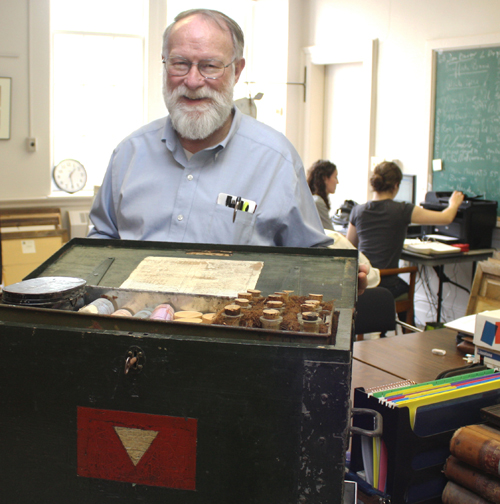
You likely won’t find turkey rhubarb, Jamaica ginger or saltpetre in your veterinarian’s dispensary today. But along with other concoctions stored in an early-1900s travelling medicine cabinet at the Ontario Veterinary College (OVC), such “materia medica” was stock-in-trade for your practitioner’s forebears.
The cabinet, with its double hinged doors and antique glass bottles, is Lisa Cox’s favourite item among a historical collection of mostly Canadian veterinary memorabilia amassed at OVC over decades and now being organized for the college’s 150th anniversary in 2012.
More than 10,000 pieces in all – including early surgical tools and instruments, books, photos, diplomas and First World War mementoes – fill tabletops, cabinets and floor space in the OVC seminar room housing the C.A.V. Barker Museum of Canadian Veterinary History.
Besides the medicine cabinet – a possession of early OVC principal E.A. Grange – Cox points out a framed diploma given to a John Sanderson in 1868. That was only six years after Andrew Smith, the college’s first principal, began giving lectures to veterinary students in Toronto. Signed by Smith, it’s the oldest diploma in the collection.
Glancing around at the collected items, Cox says, “It’s such an interesting part of the college history and the University history.”
A PhD history student at U of G, she has been cataloguing the collection since May along with University professor emeritus Ian Barker and two other history students – master’s student Melissa Segeren and undergrad Jennifer Bardon. They hope to make their database of written records and photographs available on the Internet.

Many items will be displayed in the OVC museum room during the college anniversary next year. Others will appear in an exhibit planned for the Guelph Civic Museum in 2012. Still others – mostly photos and portraits, diplomas, farriery books and other paper items – have been added to the OVC collection in the U of G Library archives.
This collection is the oldest – and perhaps the largest – of its kind in Canada, says Barker, who retired from the Department of Pathobiology last year. Among his favourite items is a wooden cane whose hollow shaft contains a telescoping measuring stick for gauging a horse’s height (in hands, of course). The stick belonged to John Rutherford, an 1879 graduate who became Canada’s first veterinary director general.
The collection contains numerous items from the Canadian Army Veterinary Corps that served overseas during the First World War, including several field chests and a Webley 38 revolver (spiked to make it unusable today). Along with photos of inter-year OVC hockey teams, there’s a 1930s tournament shield donated by then-principal C.D. McGilvray for house-league hockey.
Other pieces include a dungeon’s worth of fearsome-looking instruments: long-handled dental forceps, mouth specula, fleams for bloodletting. Barker hefts an iron rod almost as long as his forearm with a bent arrow-shaped head. He explains that early vets used such firing irons to deliberately burn horses’ skin, believing that acute injury could cure chronic conditions.
The collection is named for his father, University professor emeritus Clifford Barker. An OVC grad, a long-time faculty member in clinical studies and an avid veterinary historian, Clifford died in 2002.
Most of the pieces had been collected by the 1980s and stored in a basement vault. Ian, also a grad who studied and taught at OVC for decades, has continued to receive items. Most of the pieces will be stored back in the vault after a thorough cleaning.
He says the collection “shows the evolution of veterinary medicine as a profession, from farriers who treated animals but had no medical background through to describing the evolution of the Ontario Veterinary College.”
The collection also tracks demographic changes in the profession – including shifts from mostly rural to largely urban practices and from large-animal to small-animal medicine – and OVC’s enrolment swing from mostly male to largely female.
Cox studies the history of disease, especially bovine tuberculosis, which was eradicated in 1961 after decades of effort. She says handling old items like a meat inspection kit and an ear punch used to mark diseased animals has added a visual element to her studies. “It’s been really rewarding to see the instruments used.”
Cox will speak about the OVC collection this fall as part of her department’s series of rural history roundtables.